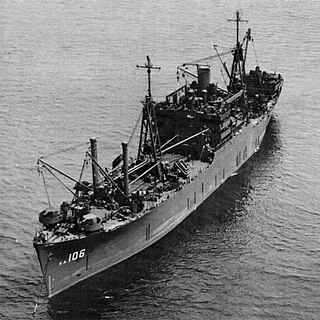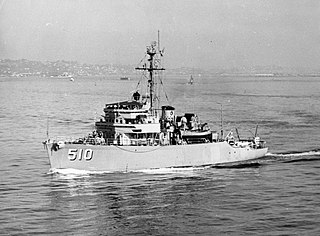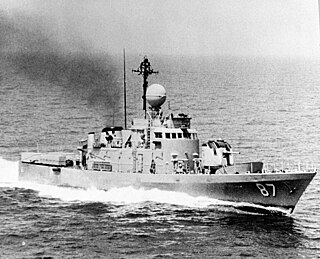
USS Benjamin Stoddert (DDG-22), named for Benjamin Stoddert (1751–1813), Secretary of the Navy from 1798 to 1801, was a Charles F. Adams-class guided missile armed destroyer in the United States Navy.

USS Berkeley (DDG-15) was a Charles F. Adams-class guided missile destroyer in the United States Navy. She was named for Major General Randolph C. Berkeley, USMC (1875–1960), a Medal of Honor recipient for actions during the U.S. occupation of Veracruz (1914).

USS Abnaki (ATF-96) was the lead ship of the Abnaki class of fleet ocean tugs in the service of the United States Navy, named after the Abenaki tribe of Native Americans. She was laid down on 28 November 1942 at Charleston, South Carolina by Charleston Shipbuilding & Drydock, launched on 22 April 1943, sponsored by Mrs. James Mayon Jones, and commissioned at the Charleston Navy Yard on 25 November 1943 with Lt. Dewey Walley in command. Abnaki earned three battle stars for service during the Korean War and 10 battle stars during the Vietnam War.

USS Albert David (FF-1050) was a Garcia-class destroyer escort, later reclassified as a frigate, in the United States Navy. She was named for Lieutenant Albert David, a Medal of Honor recipient. His was the only Medal of Honor awarded to a member of the Navy in the Atlantic Theater of Operations in World War II. Laid down on 28 April 1964 and commissioned on 19 October 1968, the Albert David served in the Pacific, including performing gunfire support operations in Vietnam during the 1970s. She was briefly deployed to the Arabian Sea in September and October 1982. On 18 September 1989 she was leased to the Brazilian Navy, and then sold to Brazil where she served as the destroyer Pará until 12 November 2008 when she was decommissioned and put in reserve.

USS Union (AKA-106) was a Tolland-class attack cargo ship of the United States Navy, the fourth ship with this name, and served as a commissioned ship for 25 years and 1 month.

USS Badger (FF-1071) was a Knox-class frigate in service with in the United States Navy from 1970 to 1991. She was sunk as a target in 1998.

USS Wiltsie (DD-716) was a Gearing-class destroyer in the United States Navy. She was named for Irving Wiltsie. The destroyer entered service in 1946 and remained active with the United States Navy until 1977, when Wiltsie was decommissioned and sold to Pakistan in 1977. The vessel entered service with the Pakistan Navy as PNS Tariq (D165) in 1978. In 1990, the ship was renamed PNS Nazim to allow the name Tariq to be given to a newly-acquired Type 21 frigate. The ship was then transferred to the Pakistan Maritime Security Agency and used as an alongside "at sea" headquarters for the agency. Though afloat, the vessel no longer sails.

The Asheville-class gunboats were a class of small warships built for the United States Navy in response to the Cuban Missile Crisis. The class is named for a city in western North Carolina and the seat of Buncombe County. All Asheville-class gunboats have since been donated to museums, scheduled for scrapping, or transferred to the Greek, Turkish, Colombian and South Korean Navies. The last two Asheville-class gunboats in US service were USS Chehalis and USS Grand Rapids, which were operated by the Naval Surface Warfare Center until they were stricken in 2016.

The fourth USS Worden (DLG/CG-18), a Leahy-class cruiser, was a ship of the United States Navy named in honor of Admiral John L. Worden. Originally called a "destroyer leader" or frigate, in 1975 she was redesignated a cruiser in the Navy's ship reclassification. The ship entered service in 1963 and participated in the Vietnam War.

USS Tacoma (PG-92) was an Asheville-class gunboat of the U.S. Navy and the fourth ship to be named after the city of Tacoma, Washington. Tacoma was the first in a series of revised Asheville-class gunboats. Some sources call these revised boats Tacoma- or PG-92-class, but the U.S. Navy officially designates them as Asheville-class. The keel of Tacoma was laid 24 July 1967 at the Tacoma Boatbuilding Company, in her namesake city. She was launched on 13 April 1968, sponsored by Mrs. Arne K. Strom, and was commissioned on 14 July 1969, with Lt. Frank H. Thomas, Jr., in command.

USS Albatross (MSC-289) was the lead ship of the Albatross-class coastal minesweeper acquired by the U.S. Navy for clearing coastal minefields.

USS Advance (AM-510/MSO-510) was an Acme-class minesweeper acquired by the U.S. Navy for the task of removing mines that had been placed in the water to prevent the safe passage of ships.

USS Asheville (PGM-84/PG-84) was an Asheville-class gunboat acquired by the U.S. Navy for the task of high speed patrolling in shallow waterways. The third ship to be named Asheville by the Navy, the vessel was laid down on 15 April 1964 at Tacoma, Washington, by the Tacoma Boatbuilding Company and launched on 1 May 1965, sponsored by Mrs. R. E. Harris. Asheville was commissioned on 6 August 1966, Lt. Henry Dale in command.

USS Vernon County (LST-1161) was a United States Navy, Terrebonne Parish-class tank landing ship in commission from 1953 to 1973. She saw extensive service in the Vietnam War before being transferred to the Venezuelan Navy, where she became Amazonas (T-21).

USS Antelope (PGM-86/PG-86) was an Asheville-class gunboat in the United States Navy.

The second USS Ready (PGM-87/PG-87) was a Asheville-class gunboat in the United States Navy during the Vietnam War.

The second USS Welch (PGM-93/PG-93) was a Asheville-class gunboat in the United States Navy during the Vietnam War.

The second USS Benicia (PGM-96/PG-96) was a Asheville-class gunboat in the United States Navy commissioned in 1970. She later served in the South Korean Navy as Paek Ku 51 (PGM-351).

USS Beacon (PGM-99/PG-99) was an Asheville-class gunboat in the United States Navy during the Vietnam War. She was transferred to the Hellenic Navy where she serves as PG Hormi.

USS Woodpecker (AMS/MSC-209) was a Bluebird-class minesweeper of the United States Navy, that saw service during the Vietnam War, and was later sold to the Republic of Fiji where she served as HMFS Kikau (MSC-204).



















